Integration
16 Aug 2022
National Art School – Cell Block Theatre
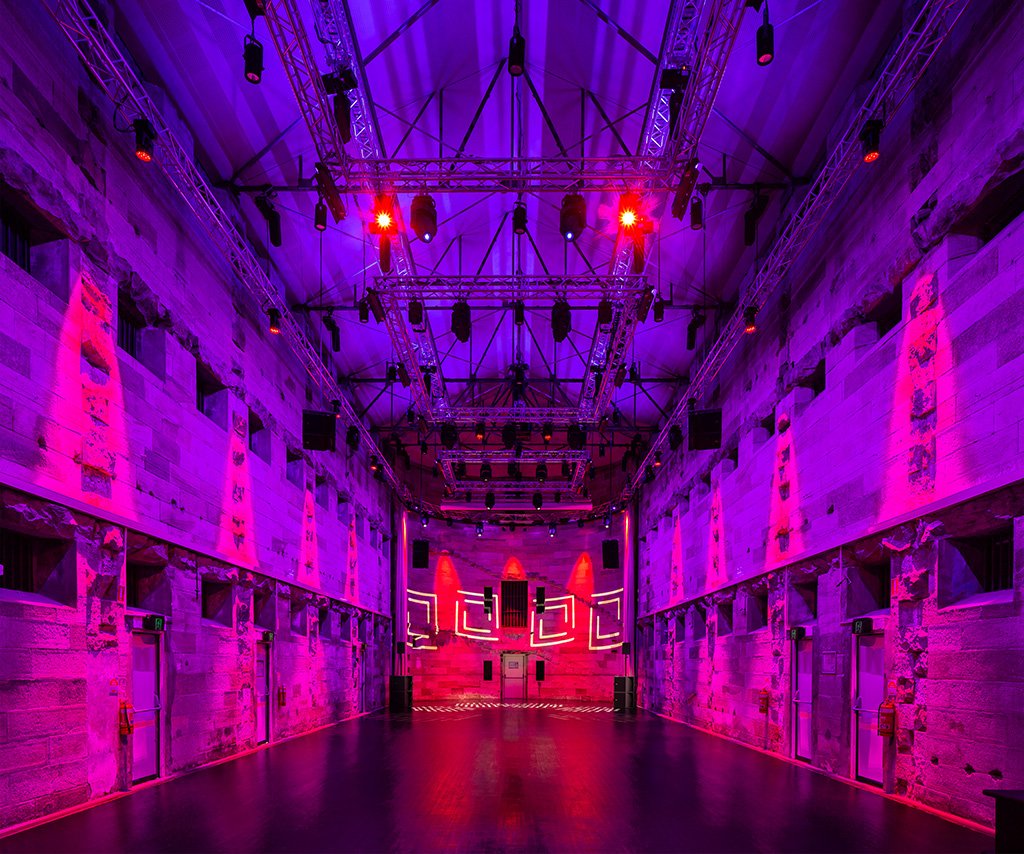
Subscribe to CX E-News
At their current location for 100 years, Sydney’s National Art School (NAS) occupies the site of the former Darlinghurst Gaol. Literally carved out of the old women’s wing of the Gaol, the Cell Block Theatre at NAS has 10 metre high, 200-year-old sandstone walls covered in reminders of its previous life. Heritage listed and totally unique, the Theatre does equal duties as a lecture hall, concert space, and high-end function venue.
NW Group were no stranger to The Cell Block Theatre, having worked production on numerous corporate events in the space. When funding became available through the NSW Government’s Arts Maintenance and Upgrade Programme, NAS approached NW to undertake consultancy and design work for a total refresh of the Theatre’s AV capabilities.
“NAS had very particular objectives for The Cell Block,” explains NW Group’s Andrew Hasler, who became Project Manager for the refurb. “The first was to service the school’s internal requirements for lectures. The second was to provide AV for school and community performances, including arts and multimedia. The next was groups renting the space that required a higher level of production, and last was providing infrastructure for companies like NW when we come in with full production.”
The biggest challenge in designing an AV system for the Theatre was the diversity of its users. “We had to design a system to satisfy all of the varying levels of tech experience,” continues Andrew. “This meant a complicated system that usually has four technicians to run it needed to be automated into a single button push. A lecturer comes in, wakes up the room, the lights come on, and two touch panel presses brings up stage light, the lectern, mics, video conferencing, and projection. At the other end, when a production company comes in, they need to be able to swap everything into full production mode instantly.”
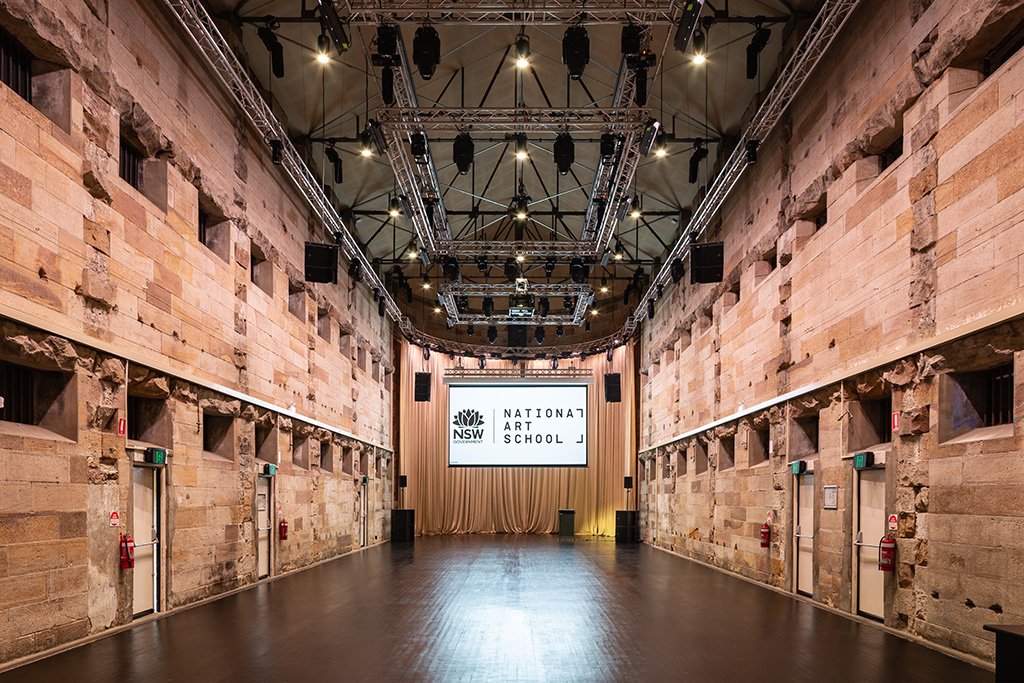
NW Group developed a design in conjunction with TAG as automation experts, Show Technology for lighting, and Michael Diener at Pollard Productions consulting on rigging. NW’s own Ian Shapcott handled audio design, as well as NW staff taking care of video, with NW’s George Blackley as site manager. The job went out to tender, and NW Group won the gig in August 2021. Working under principal contractor FDC and around Sydney’s big lockdown, work started in November and was handed over in February 2022.
Work on site was tricky due the heritage overlay. This meant not just looking after floors and walls, but certain parts of the building are designated as “archaeological”, so must continue to display historical features such as old timber slots, the architecture of the gaol, and more. Penetrations into the sandstone walls were a no-no, but NW were allowed to drill into mortar joints. Appropriately, what became the ops corner was historically a padded cell!
Automation
Adrian Riddell, System Design Engineer at TAG, was approached by NW Group and suggested QSC’s Q-SYS would be the optimal platform for automating the entire AV system. Adrian’s initial design was handed over to NW Group, and their site manager relished learning the platform, handling the integration of Dante audio, lighting control, video automation, and camera switching.
Q-SYS triggers simple pre-set house light settings, AV presets including ‘lecture’ or ‘cinema’ mode, and can flick the whole rig into expert ‘production’ mode. Q-SYS automatically detects video inputs throughout the space and sends them to the projector. A Barco PDS4k switcher is located at the ops position, taking inputs from HDMI wall plates on either side of stage and at the lectern. For video conferencing, Q-SYS connects external microphones and cameras.
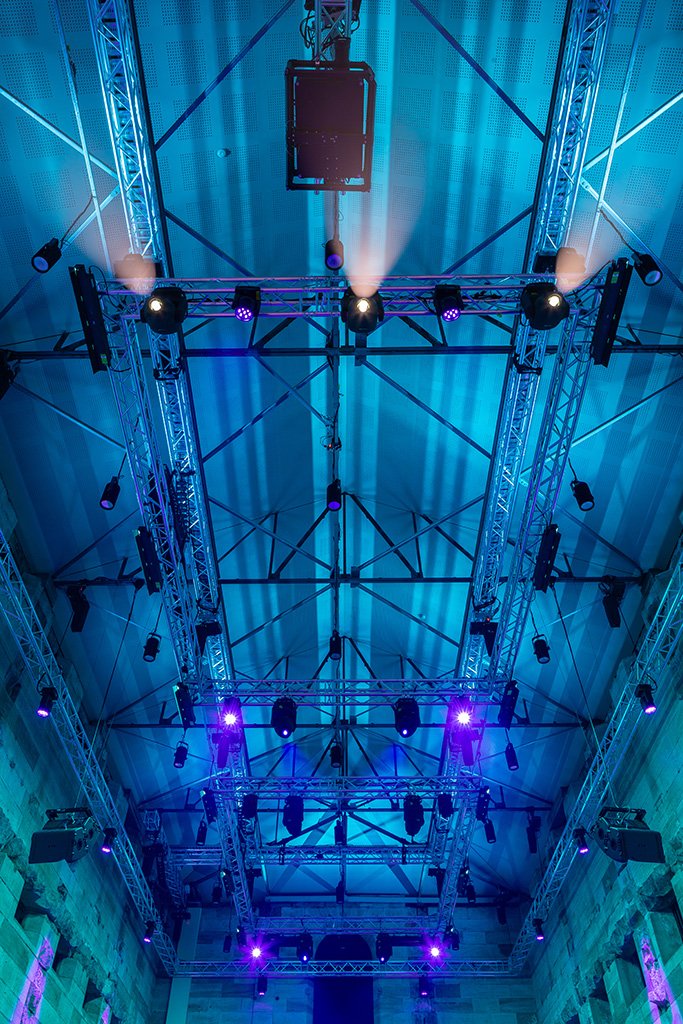
Audio
The Theatre is a 25 metre long room with sandstone walls and a wooden floor. Keeping acoustic energy tamed was the goal of the acoustic design. Ian Shapcott’s solution was four elements of L-Acoustics A10 per side with two elements hung as delays. The speakers are steered in from the walls, and hung low enough that they’re not spraying energy aimlessly into the cathedral-like space. Two L-Acoustics KS21 subs handle low-end, and there are two L-Acoustics X8s set as front fill. Six additional X8s are available as foldback.
At ops, a Yamaha QL1 mixing console takes signal from a Yamaha RIO 3224-D2 stage box via Dante. Eight channels of Shure ULXD4 wireless mics are in-house, with eight handheld and eight belt pack transmitters.
Video
With the previous projection system consisting of an underwhelming 2000 lumen projector onto a small screen, it was more than time for an upgrade. A Barco UDM-4k22 in now connected via fibre and covers a Screen Technics 250” 16:9 electronic roll down screen that’s around 6.5m wide.
Q-SYS NV-32-H video encoders at the lectern and ops enable users to connect directly to the system, in addition to the other HDMI inputs around the venue.
A Panasonic PT-RZ120BE is currently being installed to project images on the curved wall behind stage.
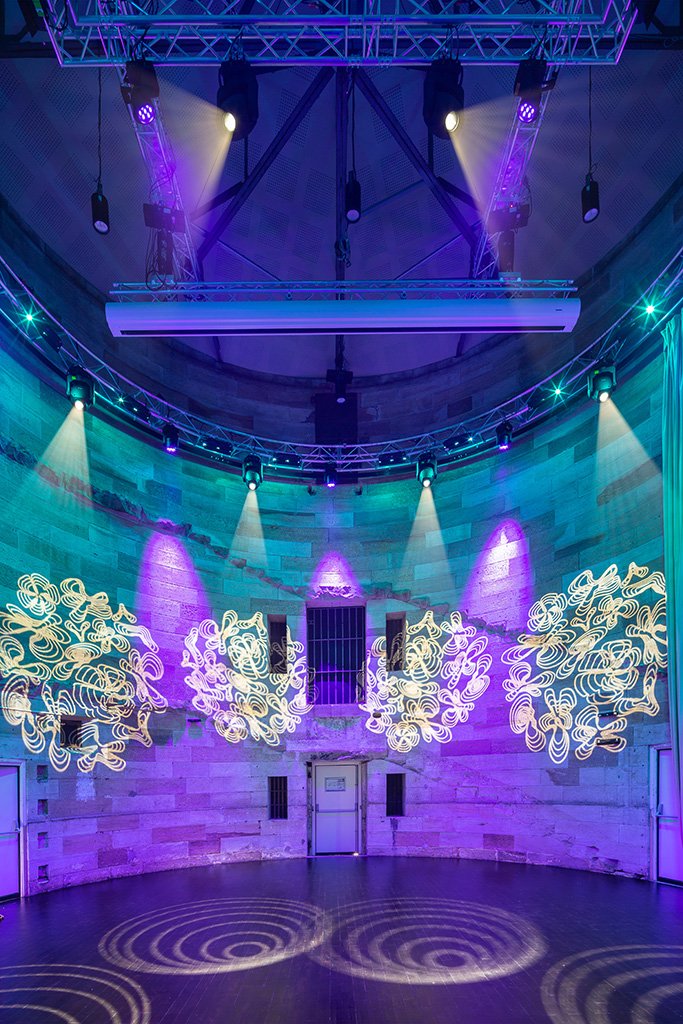
Lighting
The lighting system is controlled via a Grand MA3 compact over an Art-Net network across ELC
switches and nodes. Each lighting truss has its own ELC node. The main lighting fixtures are Martin ERA400 and Clay Paky Mini-B LED movers. The lighting design focuses on delivering comprehensive theatre stage lighting with two rows of front light and one row of backlight for film or orchestral requirements. House lights are an RGBAL fixture with variable colour temperature from 2800k – 6500K in 15ch mode to allow for maximum integration into the event lighting design.
Prolights EclCyc 100 and 050 fixtures wash the walls of Cell Block Theatre, with Fusion bars Q XV lighting the ceiling. The ELC showSTORE controls house lights from its preset, four step-dim, via the Q-SYS touch screen located at the main entry. House lights can be controlled via the GrandMA3 in production mode, giving complete control of all colour and colour temperature parameters
Rigging
Taking into consideration the low capacity of the roof trusses that date back to the 1950s, NW Group were well aware of the limitations on what they could hang. There was also the matter of the school being able to operate the system without qualified riggers present. Consulting with Pollard Productions, NW were steered towards a Kinesys Vector console, which allows limits to be set for loads, points and group trusses, and can automate the parameters of everything a rigger would be required to check. A multi-level user hierarchy gives access to control based on skills and qualifications.
A mother truss was dead-hung from roof beams, with pick-up points as required. All cabling resides in trays above the mother truss, where it’s distributed to speakers, stage boxes, and stage plates. “There’s no fixings or attachments you would typically use in an install because of the heritage overlay,” observes Andrew. “The tech we’ve used to install the systems are therefore a bit more ‘temporary event style’ rather than ‘install style’.”
29 permanent motors support the truss. Libra load cells actively monitor load weights and will stop movement if points or trusses are overloaded, underloaded, or become out of level by more than 50mm. Each truss has a ‘home’ and ‘working’ height setting, while the projector and screen trusses have a ‘show’ height. There are four additional hoist positions located in the centre of each pod and one on stage. These have been installed with a Libra load cell to facilitate scenic elements or aerialist performances and are operable via the Vector console.
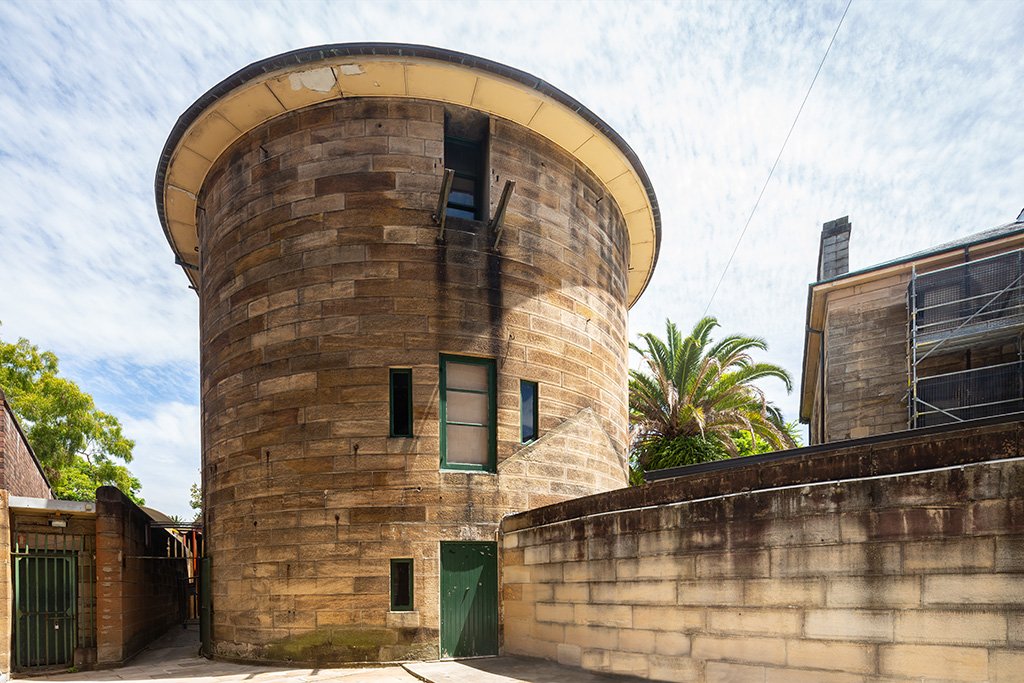
Video Equipment
Screen Projector – Barco UDM-4k22
Screen – Screen Technics 250” 16:9 electronic roll down (6m wide)
Rear Wall Projector – Panasonic PT-RZ120BE
Camera – QSC PTZ 12°x 72°
Switcher – Barco PDS4k
Video Encoders – 2 x Q-SYS NV-32-H
HDMI Input – 2 x Visionary Solutions Duet HDMI wall plate (switched from Barco PDS4k)
Audio Equipment
Control Desk – Yamaha QL1
Stage inputs – Yamaha RIO 3224-D2
Network – Dante
Speakers
– 10 x L-Acoustics A10 (4 x line array)
– 4 x L-Acoustics KS21 Sub
– 2 x L-Acoustics X8 front fill
Amps – 6 x L-Acoustics LA4X
Foldback – 6 x L-Acoustics X8
DJ Kit
– 1 x DJM900 Mk2
– 2 x CDJ3000
– L-Acoustics 108p (foldback)
Lighting Equipment
Control Desk – Grand MA3 Compact (running in MA2 mode)
Network, Playback & Protocol
– 2 x ELC showSTORE
– 1 x ELC SwitchGBX10
– 2 x ELC Switch5
– 7 x ELC Node3
– 1 x ELC NodeGBX8
– DMX512, Art-Net, RS232 (Q-SYS to showSTORE)
Dimmers – 2 x LSC UniTOUR36 (total 180a 3p)
Lighting Fixtures
– 21 x Martin ERA400 CLD
– 30 x Clay Paky Mini-B
– 18 x Prolights Cyc100
– 8 x Prolights Cyc050
– 12 x Fusion Bar Q XV
– 31 x LED House light
Atmospherics – 2 x Unique Hazer 2
Rigging Equipment
Control desk – Vector Console
Motor control – 5 x Digi Hoists
Hoists – 29 x Stageket 500kg BGV D8
Load Cell – 33 x Kinesys Libracel
Subscribe
Published monthly since 1991, our famous AV industry magazine is free for download or pay for print. Subscribers also receive CX News, our free weekly email with the latest industry news and jobs.




